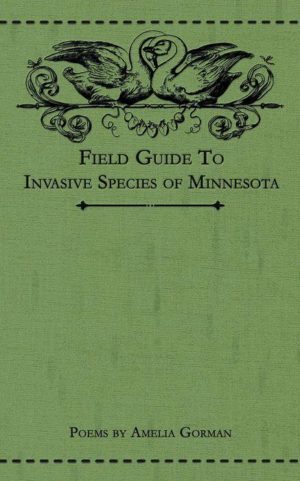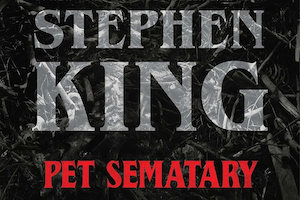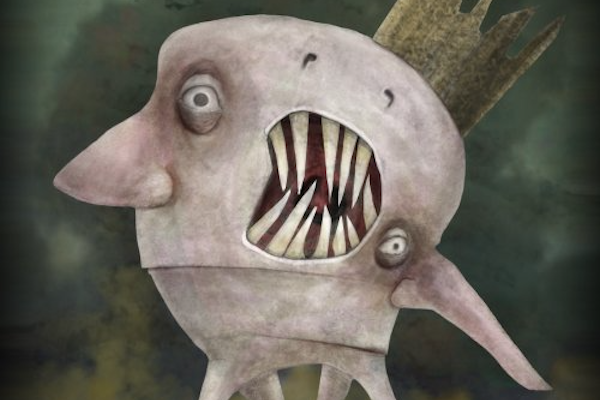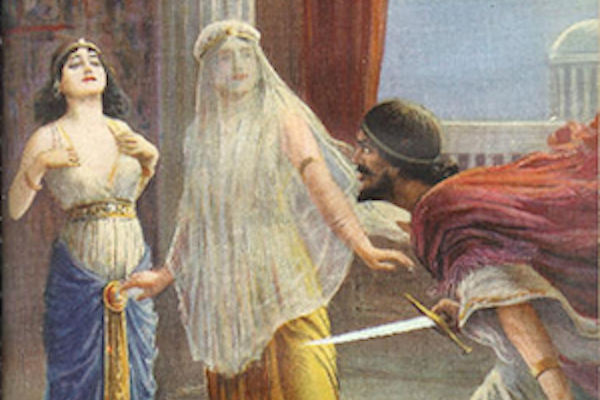Welcome back to Reading the Weird, in which we get girl cooties all over weird fiction, cosmic horror, and Lovecraftiana—from its historical roots through its most recent branches.
This week, we celebrate National Poetry Month with Amelia Gorman’s Field Guide to Invasive Species of Minnesota, first published in 2021. Spoilers ahead, but we encourage you to pick this one up for yourself.
There is no catching the fruits that shivered, quivered, and rivered inside you. There is no eating back the bush—
The place is Minnesota, home of “huge swathes of rural areas with only a handful of what people would consider ‘larger cities,’ with beautiful parks, libraries, and arts nonprofits.” It also has “some of the worst inequality in the country, the most segregation, and the most violent policing,” along with the mixed blessings of “prairies, birch forests, sandstone bluffs, night markets, brownstones, NIMBYism, and collectives.” Oh, and it can boast “four impossibly dramatic seasons per year.” Roast in summer, freeze in winter, spring thaw, autumn cool-down. Long for the change of season, grow sick of it, yearn for the next. Some weaken and move south. The rest can glory in their hardiness.
The time is the near future. The years 2044 and 2045 are mentioned; the narrator of “Silver Carp” was seven years old in 2045, so add ten or twenty or thirty years onto that according to the level of maturity you sense in their musings. Don’t age them enough to push them into the 2100s, though. Gorman is writing about a world of “climate change and ecological damage we will have to live with, not one foisted off ‘til the next century.”
For an objective field guide to Gorman’s twenty-one invasive species, turn to the website of the Minnesota Department of Natural Resources, for what she offers is the wide-ranging and often tortuous subjectivity for which poetry is the ideal vehicle. A handsome botanical (or zoological) illustration of the titular invasive precedes each poem. What follows? One waterweed may become a “submersed sybil,” another an “executioner” who “knows where all the bodies are: clinging to her.” Earthworms sing of their own fecundity beneath human collapse. Foxglove has no medicinal value once humans have shed their bodies for a digital existence. The floral hemorrhaging of Queen Anne’s Lace, on the other hand, creates “wild vegetable humans” who can survive a famine year through photosynthesis. Lampreys, having “effortlessly swapped lake for sea,” now adapt to space travel. Starry stonewort hosts the constellations that oversee the astrology of the future. Someone eats walnut twig beetles when the crops fail and contracts the thousand cankers disease it supposedly only transmits to trees. A zebra mussel “bounty hunter” collects the bivalves while watching fish grow legs and snapping turtles fur; dead raccoons spill pearls while the “bounty hunter” thrills at the thought of what’s growing inside their own body.
Buy the Book


Field Guide to Invasive Species of Minnesota: Poems
Invasive species, like all living things, are both “beautiful and weird.” Paradoxically, the “biggest ecological danger [they pose] is the monoculture they create,” thereby threatening other beings equally “beautiful and weird.”
By implication, what is the most invasive species of Minnesota and indeed of all the Earth?
What’s Cyclopean: So many amazing lines. “We’ll learn dead hobbies like turnery and touching.” “Love is treatment, flowers kind, hoaxes are the oldest medicine we know.”
The Degenerate Dutch: Even as interspecies barriers break down, humans still make class distinctions: The flea circus ringmaster used to pull mud-sledges full of tourists through dying riverbeds.
Weirdbuilding: When Cthulhu and the sea and the temperature rise, everything will change. And no, you can’t predict how. Might as well check those Starry Stonewort horoscopes.
Libronomicon: Amelia Gorman, in her author’s note, discusses reading about fungi from Yuggoth in Mushroom Rock State Park. “Everywhere I went, I saw books in these landscapes, or landscapes in these books.
Madness Takes Its Toll: What would madness even mean, in this setting? “Beware of parasites and other thoughts that burrow too deep to remove.”
Anne’s Commentary
In her author’s note, Amelia Gorman lists things she did while living in much-invaded Minnesota. One was writing all the poems in Field Guide; another was making her first professional short story sale. That story was “Bring the Moon to Me,” which appeared in Silvia Moreno-Garcia and Paula R. Stiles’s She Walks in Shadows (2015). Two years later, more or less, Ruthanna and I covered “Bring the Moon to Me” in the Lovecraft Reread, waxing enthusiastic. I was particularly impressed by “the poem-intense density of Gorman’s prose,” how she gracefully packed so much content into a thousand words. A whole apocalypse, in fact!
Remembering this, I’m gratified but not surprised by how she compresses another apocalypse—and a real ongoing one—into a slim poem cycle. Speaking of poetry…
It’s well and truly Poetry Month now that the New York Times Book Review has put out an issue devoted to the form. Sort of like seeing the first robin of spring, though in Rhode Island some robins are permanent residents. Let’s say instead the first junco of winter. So far, hereabouts, these birds haven’t altered their seasonal range, but who knows what climate change may bring?
One of the NYTBR essays this week is Elisa Gabbert’s The Shape of the Void: Toward a Definition of Poetry. Toward is the operative word there, because as Gabbert will conclude, “Poetry is liquid.” She opens with the “obvious” definition: “If the words have rhyme and meter, it’s poetry.” Does she mean to leave out blank verse (which has meter but not rhyme) and free verse (which dispenses both with rhyme and a consistent meter)? No, she includes these forms in her next observation: “And since words in aggregate have at least some rhyme and rhythm, which lines on the page accentuate, any words composed in lines are poetry.”
By lines, I take it she means strings of words that don’t conform to the margins of standard prose, breaking simply because space has run out; she means strings of words the writer breaks intentionally, so that each break carries meaning. Poetry often leaves a lot of white space on the page. In doing so, it’s “constantly reminding you of what’s not there,” creating a “hyper-present absence.” Poetry “leaves something out.” Thus it creates Gabbert’s titular void. Visual artists know the importance of this sort of “negative” space, how it compels the viewer to fill in what’s not given, or not given clearly. Gabbert once more:
The poetic is not merely beauty in language, but beauty in incoherence, in resistance to common sense. The missingness of poetry slows readers down, making them search for what can’t be found. The encounter is almost inherently frustrating, as though one could not possibly pay enough attention. This is useful: Frustration is erotic.
For me it was perfect timing that Gabbert’s essay came out this weekend. I was struggling to describe my reading experience of Field Guide, the more so because it was a profound one. Each read-through (five in all, with some poems masticated even more compulsively) brought revelations. As in, re “Trapdoor Snail,” the “she” who wanted to “discard the mother of pearl and wrap her tongue into legs” was a reference to Hans Christian Andersen’s Little Mermaid. Though exactly what the fairy tale had to do with the invasive snails, I still don’t know. The connection between the two is missing, at least for me. Gabbert assures me that I don’t need to find it. I don’t need to fight beautiful incoherence. My frustration can be pleasantly provocative, if not exactly “erotic.”
“Buckthorn” had me stumped until I realized the “you” who’s “forcing your way/through the ecophagic wood/as it slavers, quavers, and slivers inside you” is the person trying to eradicate the titular pest-shrub. The speaker to “you” can then be either the eradicator (addressing themself) or the buckthorn, taunting that “soon there will be no you./Just endless, reproducing/thorns.” Which is it? Either/or is fine. Leave me be while I geek out over the image of a slavering and quavering ecophagic wood.
“Mute Swan” continues to frustrate my puzzle-solving desire to know what it means. Who is the first person narrator: a person, a swan? What’s with this cello metaphor in the first verse? Who’s about to dive in the second verse? They have a shirt with “sinking buttons,” so a person? When diving, what two things are they learning “about breaking men’s legs”? Defensive swans can break human bones with their thrashing wings. Relevant? Never mind. Leave me with the third verse where two can fathom these waters after all, then wings, then half the lake for each of them. Love. The two are mated swans, right? Did they drown the shirted person? Never mind. I love the shared lake even if it must lead to more invasive swans.
The “wild vegetable humans” of “Queen Anne’s Lace” make me happy all over, though the mechanics of their transformation into photosynthesizers remains cryptic. Ditto the “Sea Lamprey” adapting to space flight, sucked tight to shuttles that have failed their human creators. The poor guy who gets thousand cankers disease from eating the “Walnut Twig Beetle” that carries its causative fungus? There’s a horrorshow in a scant handful of lines!
Ditto the “Zebra Mussel” that’s apparently (maybe) infecting turtles and raccoons and maybe even the narrator with deadly beautiful “pearls.”
Accelerating climate change and ecosystem collapse via “monoculturation.” It’s a grim enough near-future Gorman foresees. Climate is an inanimate system. But each “beautiful and weird” invasive species obeys the universal prime directive: Survive, and then if you can, thrive. Not being alive in the case of the first threat and needing to stay alive in the case of the second render both these threats innocent. What about us? Doesn’t the prime directive apply to humans as well as the rest of animate creation?
I say yes, it does. Our failure to thrive or at least survive may come from not realizing that we’ve become the ultimate invasive species, the conscious or unconscious source of so many other invasions, in Minnesota, in every state, in every country. But we can realize stuff, can’t we? But we can think? Can’t we?
Come on, we can write poetry! We must be pretty smart. Right?
Um, right? Well, think about it, which I’ll do as I go out to battle the two most invasive species in my garden, garlic chives and ladybells (Adenophora stricta). These insidious plants have snuck into every bed, and yeah, it’s my own fault—I planted the original clumps, seduced by the flavor of the first and the flowers of both. I didn’t know, I just didn’t know, but now you all do.
Ruthanna’s Commentary
Five years ago, we waxed rhapsodic over Amelia Gorman’s “Bring the Moon to Me,” and couldn’t wait for more. So when I learned about Invasive Species of Minnesota (thank you, Marissa Lingen), I was doubly tempted, first by the author’s name and second by the concept itself. Near-future climate specfic meets weird fiction meets poetry? Yes, please! And then thrust the collection at Anne: Here, you’ve got to read this! Sharing is a pleasure that transcends the survival of ecologies, so now I’m waving this little green book in your face. Here! You’ve got to read this!
More than the neatly-wrapped little idea story that was “Moon,” this collection reminds me of the magnificent-yet-terrifying sea-rise/sea-change in Livia Llewellyn’s “Bright Crown of Glory.” (As Sonya Taaffe would say, if we find a third it’ll be a sub-genre.) In the weird version of our current apocalypse (or, um, apocalypses), we’ve broken our ecosystems so much that they break down. But this is no ordinary extinction event: It’s a loss of the boundaries between different species and kingdoms, between humans and the things we failed to value. Everything blurs and shifts until the world is no longer ours and we are no longer ourselves. “I try to remember the way the world is supposed to work.”
So humans die of tree plagues, flowers pollinate insects, and the Department of Natural Resources hands out stingy rations. But as in any good uncaring universe, not all change is destructive and some destruction is creative. Lampreys are adapting to outer space. Perhaps the blood from Queen Anne’s Lace will turn you photosynthetic. Perhaps you’ll skid on the pearls from a dead raccoon, out of this hot hell and into thrilling darkness.
I’d like to drop Jonathan from “The Essayist in the Wilderness” into this invasive ecosystem, and see what he thinks of Gorman’s crayfish. Then again, Gorman has all the nature-drawn philosophical insight that he lacks, moving from fur-scruffed snapping turtles, to accusatory descriptions of human nature—“You always wanted the end of the world.”—to hope that something will survive. Maybe even something of humanity, though it may not be recognizable. Maybe change is how we live beyond our own failures—moving from a species that modifies its environment to one that excels at being modified. Maybe that’s how everything that endures will do so. “Breaking,” as the brittle naiad teaches, “is its own survival strategy.”
There are peeks at worldbuilding here, too: the acidification of 2044, childhood memories from 2045, the hunger that rears again and again amid zebra mussels and starry stonewort. There is a consistent illogic to the shifts in the Minnesota ecosystem, drawn from a thorough local knowledge: Gorman is working with a landscape familiar enough to thoroughly defamiliarize. In her Author’s Note she talks about accidentally opening the bait fridge full of invasive nightcrawlers at her grandparents’ house, and about helping with buckthorn removal.
And if a single state has gotten this strange, we can only imagine what celandine is doing in DC or what rabbits have become in Australia. The world, maybe the universe itself (now invaded by lampreys) has grown beyond what we can understand, even with a skilled guide. That doesn’t make it any less worth exploring, or the guide less worth following.
Next week, we continue Joseph Sheridan Le Fanu’s Carmilla with Chapters 11-12, in which we finally learn the General’s story.
Ruthanna Emrys’s A Half-Built Garden comes out in July 2022. She is also the author of the Innsmouth Legacy series, including Winter Tide and Deep Roots. Her short story collection, Imperfect Commentaries, is available from Lethe Press. You can find some of her fiction, weird and otherwise, on Tor.com, most recently “The Word of Flesh and Soul.” Ruthanna is online on Twitter and Patreon, and offline in a mysterious manor house with her large, chaotic, multi-species household outside Washington DC.
Anne M. Pillsworth’s short story “The Madonna of the Abattoir” appears on Tor.com. Her young adult Mythos novel, Summoned, is available from Tor Teen along with sequel Fathomless. She lives in Edgewood, a Victorian trolley car suburb of Providence, Rhode Island, uncomfortably near Joseph Curwen’s underground laboratory.












